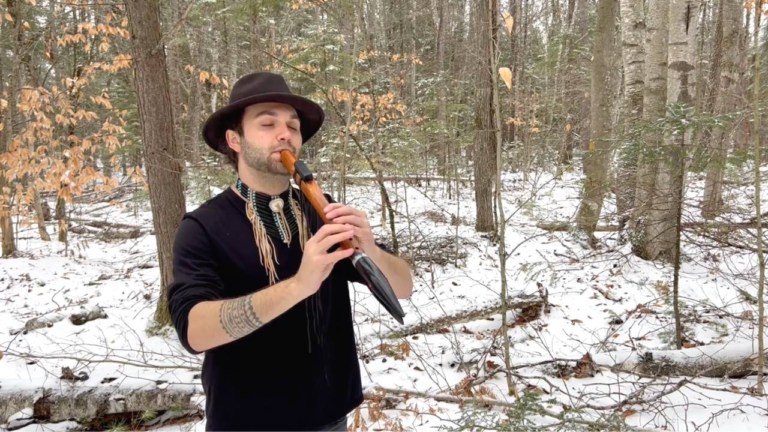The world of sound healing knows no boundaries, and neither do the sound healing tools we can use to work with the power of their healing sounds.
In this article we came into contact with sound healer Gareth Laffely. Gareth, a Native American composer and producer, tells us how to introduce the Native American flute into your sound healing sessions, its history and much more.
The history of the Native American style flute
Native American flutes are an evolution of sound that has been shaped over the past 3,000 years. In North America, one of the oldest flutes is the Anasazi flute from the American Southwest.
As history unfolded, flutes became known in many Native American tribal cultures, from elderberry flutes of the Penobscot tribes of Maine to the courtship flutes of the Great Plains. Many different sounds emerged. Flutes were made by hand and each flute had a unique tuning that depended on the size of a flute maker’s hands and forearms.
The Native American flute has been refined into a standardized instrument with many healing benefits. Most flutes are now tuned in the minor pentatonic scale at 440 Hz or 432 Hz.
The Native American style flute and your sound healing practice

The beautiful Native American style flute can be used for meditation and relaxation and can also be a powerful tool to integrate into your sound healing practice. The next three sections explain how to introduce this special flute into your healing sessions through transitions.
Client connection
During the beginning of a 1-2-1 sound healing session with a client, perhaps the most crucial step is connecting with the client.
Sometimes, especially if it’s a new customer, there can be some hesitation or a barrier to connecting. Introducing the flute to this part of the session allows the client to relax while allowing the sound healer to observe how the client responds to sound.
Here are two steps you can try:
1. Have your client sit or lie down and invite him to close his eyes and take a few deep breaths
Using breathwork in a session has a number of benefits, including the following:
- Reduction of anxiety and depression
- Decreasing the heart rate
- Promoting wellness and well-being
There is a breathing pattern that can be used here called ‘3-4-5 breathing’. Invite the client to inhale to a count of three, hold the breath to a count of four, and exhale to a count of five. Have them repeat this pattern several times.
As the client begins to breathe, begin to gently play your Native American-style flute next to his or her body (2 to 3 feet away). And now notice how they react? Are they tense? Do they begin to change their breathing into a more relaxed state?
Continue to observe the 3-4-5 breathing pattern and time several slow flute melodies with their 5-second exhalation. This helps the client stay focused on their breathing while feeling a musical guidance as they release. Once you see the client’s muscles relax, put down your flute and begin the process of connecting with the client.
2. After the client connection, play the same melody on the flute as you begin to transition into the rest of the healing session
Transition to other instruments
During a 1-2-1 sound healing session or a sound bath, multiple instruments are often used within a short period of time.
Treat the flute as a guide that takes clients on a journey and walks with them on the sound path you paint with your healing instruments. Let the flute start a session, play a simple melody for 2 to 5 minutes and then start using your other instruments.
For example, if you are about to switch from a gong to a tuning fork, play the same familiar melody on the flute as you move from one instrument to the other. The consistency will help keep customers grounded and engaged. Because flutes are lightweight and portable, they can be easily played while walking through a healing room. Flutes can also be played with one hand, so they can be used while striking a singing bowl or gong.
End a Sound Healing session
At the end of a sound healing session, the flute can be a wonderful way to re-energize clients.
If a client is in a deeply relaxed state, the flute can be used to create an upbeat melody to slowly increase awareness. After 2 to 5 minutes of flute playing, other grounding instruments (such as a shaker or ocean drum) can be used to complete the session.
Final thoughts
“The flute is perhaps the best way to convey emotion during a healing session. You can visibly notice a change in people as you pour your breath into the flute and listen to the song. In my years as a hospice volunteer, I have seen firsthand the peace this instrument can bring, and I strongly encourage others to let the Native American-style flute speak through them as well.” – Gareth Laffely, Sound Healing practitioner
There are many applications for using the flute in a sound healing setting. Some options include:
- Nursing
- Healthcare work
- Education
- Working with children
- Working with animals
- Sound baths
If you would like to learn more about the Native American Style Flute, please sign up for our FREE online Sound Healing course, The Native American Style Flute – An Introduction!
What to read next:
Stay informed about news and updates!
Join our mailing list and receive the latest news and updates from our team.
Don’t worry, your information will not be shared.
SPAM is a NO! We will never sell your information for any reason.

